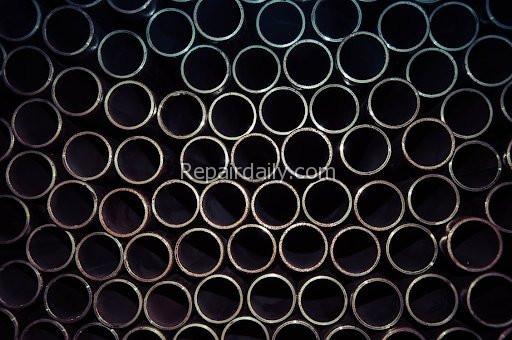

From bridges to skyscrapers – steel is used in large constructions all over the world. Stainless steel, however, is considered one of the most important building materials by construction companies.
The material is unique due to its durability, performance, high tensile strength, yield strength, flexibility, configuration adaptability, and good thermal conductivity, as well as being resistant to corrosion. Steel is also a very sustainable building material and cost-effective in the long run.
In this post, we’ll dive into the main advantages of using stainless steel in the construction sector so that you can make an informed choice when buying this construction material.
Corrosion Resistance

When it comes to metals, we often talk about corrosion being their downfall. However, one of the main characteristics of stainless steel is that it effectively prevents corrosion. This is mostly due to the chromium content. This incredible breakthrough came in 1913 by metallurgist Harry Brearley.
In stainless steel, this process is called passivation and uses nitric acid or citric acid to remove free iron from the surface. This creates a thin and invisible layer consisting of oxides on the surface. It occurs through a reaction between the metal and the oxygen present in the environment. The oxide layer drastically reduces the corrosion rate of the material and it is therefore said that the material has gone through a passivation process.
Emits No Toxins
Another benefit that’s not often mentioned when it comes to stainless steel is that it is a highly sustainable choice. It is usually created from about 70% scrap metal which means that it is giving life to something that is no longer used.
Steel does not emit harmful or irritating toxins and can be used in areas which need a lot of environmental protection. Metals can exist in many different forms, such as pure metal, in an alloy, as ions in a solution, or bound to other substances such as mineral or organic complexes. Depending on the shape, the metal has different properties.
Steel is an alloy of mainly iron and carbon, but several other substances can also be included, e.g. nickel, chromium, and vanadium. Stainless steel contains nickel but generally does not cause a nickel allergy. This is because nickel is tightly bound to and not emitted from steel.
Stainless steel’s impermeability also comes in handy when it comes to storage and conduction in a safe environment. This is especially paramount at construction sites where workers can use, for instance, products like a stainless steel gas can, which contributes to the safe handling and storage of gasoline and other flammable liquids. It is also a very hygienic material as it is easy to clean and sanitize and therefore it’s commonly used in construction, healthcare, food handling, and households.
Durability and Strength
A steel product with high strength has many advantages. The higher the strength of the steel, the less material is required and constructions and products can be made lighter and thinner, but still just as durable.
The basic properties of steel, such as its hardness and strength, are determined by its microstructure. In the microstructure of the steel, changes occur when it is processed to get its final shape, e.g. when the steel is rolled, forged, or drawn to become sheet metal or wire.
Different machining methods affect the microstructure of the steel in different ways and therefore the impact on the material properties can also be large. Different types of heat treatment also have a great influence on the final properties.
When steel is used as a construction material, its strength is of great interest. The nature of the construction determines important properties, but often there is much to be gained from being able to make thinner and more flexible constructions with retained strength.
The greater the strength that can be achieved, the smaller the amount of material needed to fulfill the intended function. Smaller amounts of material in turn lead to fewer transports, less resource extraction, fewer emissions, and less energy use.
Long Term Value

When you keep in mind the longevity of this building material, the total life cycle cost of stainless steel stacks up well. Also, when you consider that the maintenance cost for stainless steel is fairly low, you will be guaranteed to get great returns when choosing it as your material.
Final Thoughts
Because of its durability, strength, sustainability, and cost-effectiveness, stainless steel brings a host of benefits to the construction industry. Structures can be easily modified and repaired, and stainless steel makes the investment worth the while since it doesn’t require much maintenance and boosts overall safety.
I'm so excited to tackle all my home improvement projects! From plumbing to DIY and cleaning - I'm ready to get down to work! #homerepair #homecleaning #plumbing #diy #fixerupper #realestate #renovation #interiordesign #farmhouse #diy #homedecor #hgtv #home #farmhousedecor #modernfarmhouse #farmhousestyle #fixerupperstyle #fixandflip #homerenovation #realestateinvesting #beforeandafter #homesweethome #remodel #realestateinvestor #interior #realtor #joannagaines #flippinghouses #countryliving #design #homedesign #farmhouseinspired #investmentproperty #bhghome #renovationproject #farmhousekitchen #homeimprovement #farmhouseliving #cottagestyle #decor #realestateagent #magnoliahome #homeinspo #magnoliamarket #kitchendesign #dreamhome #shiplap #construction #houseflipping #investor #farmhousedesign #architecture #farmhousechic #homereno #rusticdecor #reno #kitchenremodel #webuyhouses #magnoliatable #rentalproperty #fixerupperinspired #newhome #interiors #homeremodel
